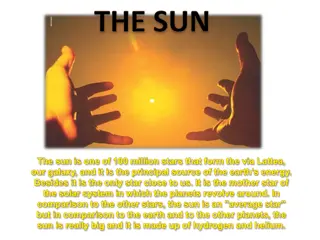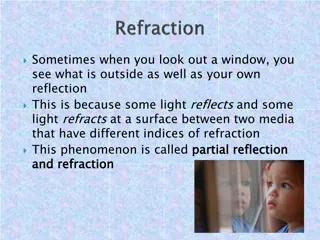Understanding Plate Tectonics: Meaning, Concepts, and Plate Margins
Plate tectonics is a scientific theory explaining the movement of Earth's lithospheric plates. Developed by various scientists, it involves the drifting of plates over the Earth's surface, leading to phenomena like earthquakes and mountain formation. The theory is based on continental drift and sea-
5 views • 7 slides
Science Week at a Glance: Climate and Weather Insights
Dive into a week of science exploration focusing on climate and weather phenomena. From analyzing atmospheric layers to understanding the impacts of moisture on weather patterns, this overview covers a range of topics including greenhouse gases, hurricanes, wind systems, and meteorological events. E
3 views • 6 slides
Space Weather: The Sun-Earth Connection
Explore the intricate relationship between the Sun and Earth, as space weather phenomena such as solar flares and sunspots impact our daily lives. Discover how disruptions in communication systems, satellite navigation, and power grids can occur due to solar activity, highlighting the importance of
5 views • 37 slides
Understanding Shape Memory Alloys: Properties and Applications
Shape memory alloys exhibit unique properties based on transformations between austenite and martensite phases. These transformations can be induced thermally or mechanically, leading to phenomena such as pseudoelasticity and shape memory effect. Learn about the thermal transformation, pseudoelastic
2 views • 9 slides
Unveiling the Mysteries of the Æther: A Metaphysical Perspective
A philosophical framework, the Æther seeks to provide a foundational understanding for interpreting "electromagnetic" phenomena. Postulated as an energetic, metaphysical background, it is considered a medium or substrate facilitating these phenomena. This proposed concept delves into the realm of p
0 views • 53 slides
Understanding Geographic Objects in GIS
Geographic objects play a crucial role in GIS by being easily distinguished and named based on parameters like location, shape, size, and orientation. These objects are studied collectively to understand their interactions and relationships, aiding in tasks such as navigation systems and route optim
4 views • 13 slides
Understanding Temperature Independent Paramagnetism (TIP) and Anomalous Magnetic Moments in Metal Ions
Temperature Independent Paramagnetism (TIP) explains the second-order Zeeman effect's magnetic susceptibility unaffected by temperature changes. Anomalous magnetic moments are observed in metal ions, deviating from predicted values based on electron angular momenta. The interaction of spin states in
1 views • 15 slides
Significance of Models in Agricultural Geography
Models play a crucial role in various disciplines, including agricultural geography, by offering a simplified and hypothetical representation of complex phenomena. When used correctly, models help in understanding reality and empirical investigations, but misuse can lead to dangerous outcomes. Longm
0 views • 8 slides
Exploring Enzyme Kinetics for Understanding Chemical Reactions
Enzyme kinetics is a vital discipline focusing on the rate of enzyme-catalyzed reactions and how they respond to varying conditions. Reactions are classified based on reactant concentration influences. Zero, first, second, and third order reactions are distinguished, with examples like first-order r
0 views • 31 slides
Electric Properties of Colloids in Liquid Media: Charging Mechanisms and Electrokinetic Phenomena
Colloidal particles dispersed in liquid media can acquire a charge through selective adsorption of ionic species or ionization of surface groups. This leads to electrokinetic phenomena like electrophoresis, electro-osmosis, sedimentation potential, and streaming potential. The stability of colloids
2 views • 16 slides
Understanding Ocean Currents: El Niño and La Niña Phenomena
Explore the impacts of El Niño and La Niña phenomena on weather patterns, from unusual warming (El Niño) to cooling (La Niña) of the Pacific Ocean. Discover how these phenomena affect regions like North America, Southern California, and North Carolina, influencing temperature, precipitation, and
0 views • 9 slides
Understanding Interfacial Phenomena in Surfactant Solutions
Micelle formation is a key process in surfactant solutions, where the critical micelle concentration (CMC) is reached leading to the formation of micelles. The CMC decreases with longer hydrophobic chains and is influenced by the addition of electrolytes. Adsorption at solid interfaces and wetting p
1 views • 21 slides
Understanding Photophysics: Emission and Luminescence Processes
Photophysics explores the emission and loss processes in luminescent phenomena, named based on the excitation mode of energy-rich species. Different types of luminescence include fluorescence, phosphorescence, and chemiluminescence. Bioluminescence in nature, such as in fireflies and dinoflagellates
0 views • 20 slides
Understanding Grounded Theory Research Design
Grounded theory research design is an inductive approach used to systematically develop theories based on data collected and analyzed. Developed by sociologists Glaser and Strauss, this methodology emphasizes staying close to the data throughout the analysis process. It involves systematic procedure
0 views • 20 slides
Enhancing Learner Understanding through Computer-Based Simulations in Teaching Electrolysis
Computer-based simulations (CBS) have the potential to improve learner comprehension of complex science concepts like electrolysis. Challenges in teaching and learning electrolysis include identifying anode/cathode, analyzing reactions, and writing chemical equations. Factors contributing to these c
0 views • 34 slides
Understanding Magnetism in Matter: Magnetization and Magnetic Field Strength
The magnetic state of a substance is characterized by the magnetization vector M, representing the magnetic moment per unit volume. The total magnetic field induction at a point within a substance depends on the applied field and magnetization M. Substances can be classified as paramagnetic, ferroma
2 views • 11 slides
Dependent Case Theory in Japanese Linguistics
Dependent case theory challenges traditional views on case assignment, particularly in the context of Japanese grammar. This theory argues for a different approach to case assignment based on interpretative processes rather than licensing conditions. The theory is explored in-depth, discussing neces
0 views • 40 slides
Understanding Differential Equations in Physical Phenomena
Differential equations play a crucial role in modeling physical phenomena involving rates of change like fluid motion, mechanical systems, and heat dissipation. This content explores examples of differential equations in motion and provides insights on sketching direction fields using tools like Map
0 views • 11 slides
Understanding Weather Through Infrared Temperature Detection
Explore the use of infrared temperature detection to study everyday weather patterns. Learn how infrared radiation emitted by objects can reveal insights into cloud cover and atmospheric conditions. Through hands-on experiments, discover the relationship between object temperatures and weather pheno
0 views • 20 slides
Understanding Flowing Gluon Fields and Color Glass Phenomena in QCD
Explore the collective phenomena of gluon fields in classical QCD, focusing on the Standard Model of URHICs, Color Glass, and Gluon Fields in the Forward Lightcone. The research delves into topics like local thermal equilibrium, viscous hydrodynamics, and the interaction of probes with quarks and gl
0 views • 24 slides
Understanding Cyclones and Associated Phenomena in Disaster Management
Cyclones are large air masses characterized by swirling winds around a low-pressure center. Mesocyclones are vortexes within storms that can produce tornadoes. Dust devils and waterspouts are related phenomena, with dust devils ranging in size and potential threat levels. Other variations include st
7 views • 8 slides
Comparison of GUI-Based and Text-Based Assignments in CS1
This study investigates the effectiveness of GUI-based assignments compared to text-based assignments in a CS1 course. The research explores how student motivation impacts their performance and retention in the course. It also delves into student preferences between GUI-based and text-based assignme
0 views • 19 slides
Understanding Human Sciences: Chapter 2 Insights
In Chapter 2 of Integrating the Human Sciences, key definitions such as phenomena, subsystems, and causal links are explored. The study emphasizes developing a map of human science to understand the intricate relationships between various phenomena. It delves into economic growth as a phenomenon and
0 views • 14 slides
Exploring Weather Phenomena and Meteorological Predictions
Dive into the fascinating world of weather phenomena and the science behind meteorological predictions in this unit of Living By Chemistry SECOND EDITION. Learn about proportional relationships, temperature scales, behavior of gases, and how to interpret weather maps to make accurate predictions. En
0 views • 19 slides
Understanding Interfacial Phenomena and Micelle Formation
Interfacial phenomena play a crucial role in the formation of micelles in surfactant solutions, leading to a decrease in surface tension. The critical micelle concentration (CMC) marks the point where micelles first form in the solution. Factors like chain length and electrolytes impact CMC and mice
0 views • 20 slides
Exploring Quarkyonic Matter and Chiral Pairing Phenomena
Investigate the characteristics of quarkyonic matter and chiral pairing phenomena in the context of dense QCD at T=0. Delve into the confinement aspects, the properties of quarkyonic matter near T=0, and the candidates for chiral symmetry breaking. Consider the implications of chiral pairing phenome
0 views • 42 slides
Fundamentals of Physical Measurements
Science and engineering rely on measurements to understand natural phenomena. Physics aims to predict future outcomes based on observed data and fundamental laws. Base physical quantities like length, time, and mass have standard units, forming the foundation for deriving other physical quantities.
0 views • 13 slides
Understanding Synoptic Meteorology: Fronts and Weather Phenomena
Fronts are boundary surfaces that separate air masses of different densities, leading to various meteorological phenomena. Cold fronts, warm fronts, occluded fronts, and stationary fronts impact weather patterns differently, affecting temperature, moisture levels, and wind direction. Understanding t
0 views • 22 slides
Role of Anomalous Triangle Singularity in Threshold Phenomena Understanding
Anomalous Triangle Singularity (ATS) is explored in the context of threshold phenomena understanding, focusing on its occurrence when all three internal particles are simultaneously on shell. The study delves into kinematic effects, genuine states recognition, and specific cases such as heavy pentaq
0 views • 36 slides
Understanding Phenomena-based Research in Information Management
Explore the evolution of modern science, the importance of phenomena-based research in connecting theory to reality, and the consequences of unreal research in the realm of technology acceptance models. Delve into the significance of relating research to the real world for meaningful impact and prog
0 views • 20 slides
Exploring Light and Optics: Reflection, Refraction, and Phenomena
Explore the fascinating world of light and optics, delving into topics like the speed of light, index of refraction, reflection, refraction, dispersion, rainbows, atmospheric scattering, and more. Understand how different colors of light are refracted, leading to phenomena such as rainbows and blue
0 views • 23 slides
Steps to Success: Conducting Scientific Experiments
Scientific experiments play a crucial role in discovering new things. Follow a specific order of steps outlined in the guide to successfully conduct experiments. Begin by understanding biological phenomena, formulating hypotheses, planning, performing experiments, observing results, and drawing conc
0 views • 29 slides
Understanding Surface Chemistry and Adsorption Phenomena
Surface chemistry is a crucial branch of chemistry that focuses on the chemical processes occurring at interfaces between different surfaces like solid-liquid, solid-gas, and liquid-gas. This field plays a significant role in various industries, including electronics. Adsorption, absorption, and sor
0 views • 15 slides
Exploring the Sun: Structure, Phenomena, and Effects
The sun, a critical star for life on Earth, exhibits various fascinating structures and phenomena. From the solar corona to solar faults, prominences, and flares, each aspect offers insights into the sun's dynamic nature. Solar flares, the most explosive events, release enormous energy and give rise
0 views • 9 slides
Quantitative Research Framework for Historical Disciplines
Scholarly communities in historical disciplines are combining quantitative and qualitative methods to study phenomena that change over time. The proposed general methodological reflection aims to enhance research in historical linguistics through quantitatively driven models and claims. Quantitative
0 views • 18 slides
NetLogo - Programmable Modeling Environment for Simulating Natural and Social Phenomena
NetLogo is a powerful and versatile programmable modeling environment created by Uri Wilensky in 1999. It allows users to simulate natural and social phenomena by giving instructions to multiple agents operating independently, making it ideal for modeling complex systems evolving over time. NetLogo
0 views • 7 slides
Resonance Phenomena in Grating Structures and Applications
Resonance phenomena in grating structures, such as dielectric or metal gratings on substrates, offer sensitive elements for detecting biological and chemical agents. The sensitivity of these structures is described by equations relating to resonant wavelength changes and the refractive index of inve
0 views • 20 slides
Understanding Comparative Politics: Power, Influence, and Political Phenomena
Politics involves power and influence, where individuals strive to achieve their goals by influencing others or breaking free from external influences. Political science delves into the study of power and political phenomena, while comparative politics focuses on analyzing political dynamics within
0 views • 21 slides
Science Bellwork Questions for Week 15
This set of bellwork questions for Week 15 covers various topics related to Earth's position to the Sun, the Sun's motion, Moon phases, and reflections on learning in science class. Students are prompted to answer questions about Earth's closest position to the Sun, sunrise and sunset phenomena, the
0 views • 5 slides
Understanding Reflection and Refraction Phenomena in Optics
Reflection and refraction are fundamental phenomena in optics, occurring when light encounters surfaces with different indices of refraction. This results in partial reflection and refraction, with the amount of each depending on the angle of incidence. Beyond a critical angle, total internal reflec
0 views • 12 slides







































